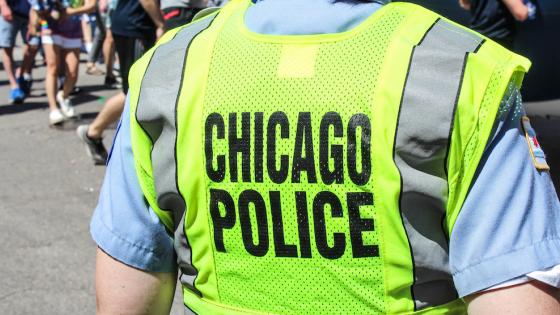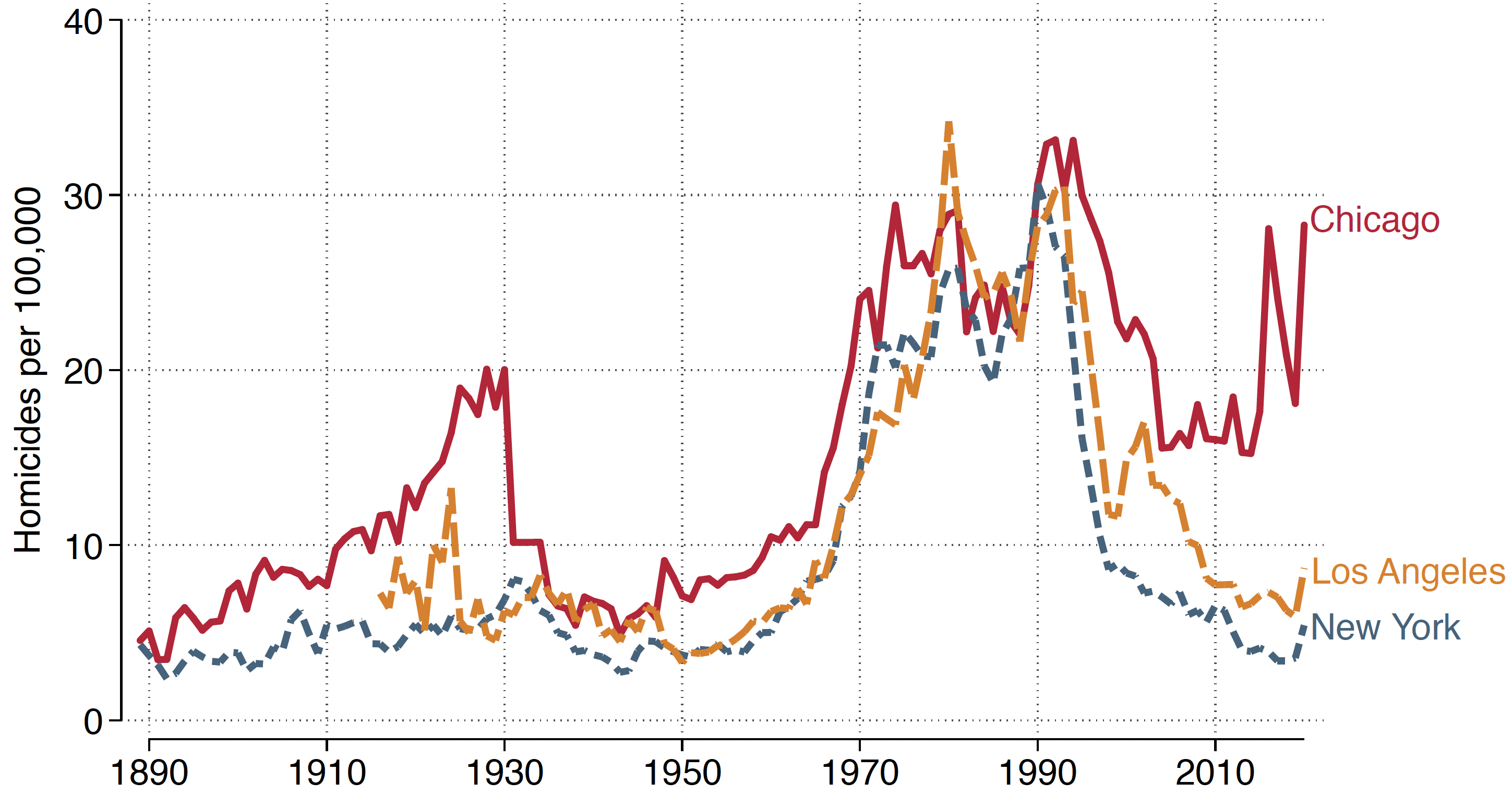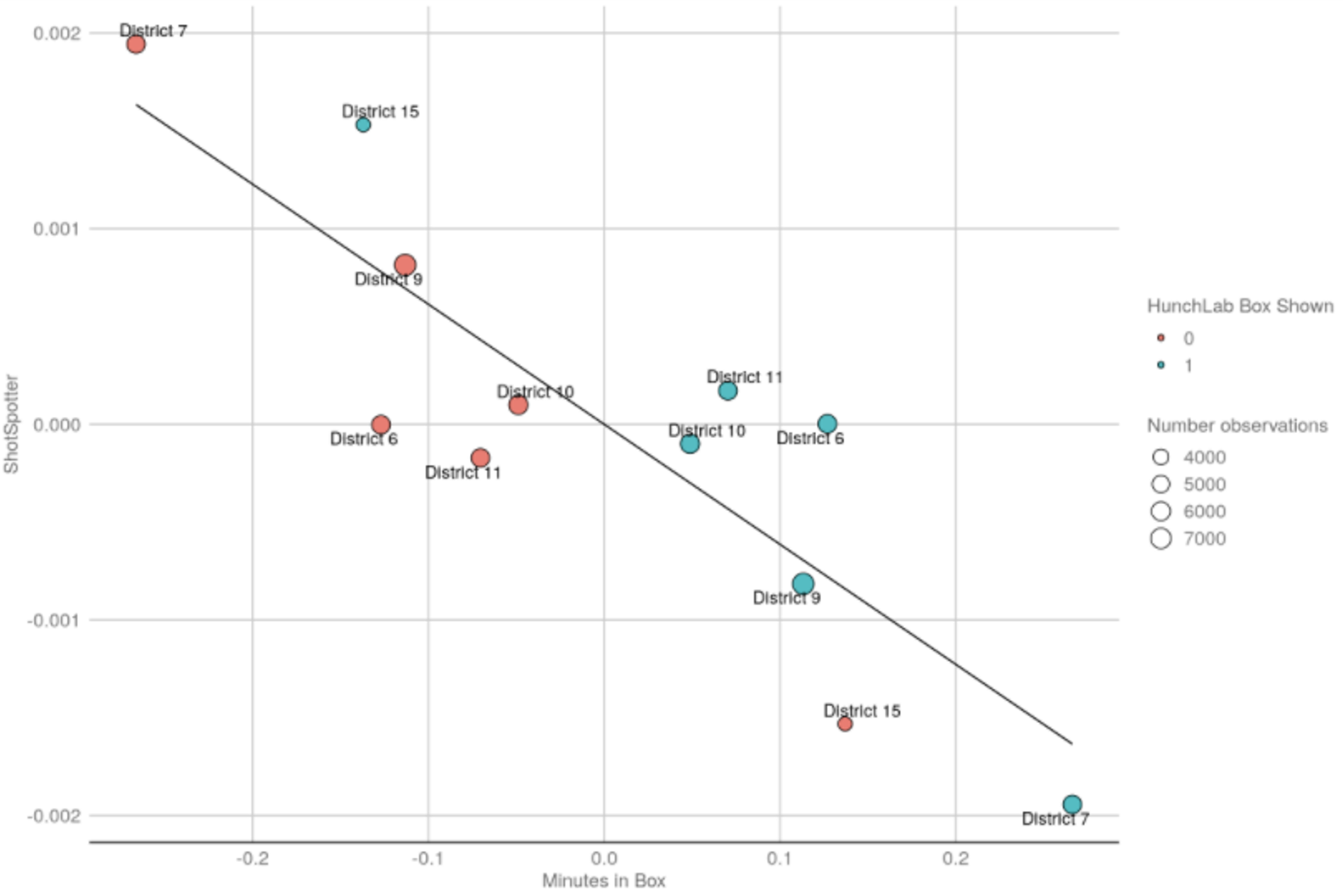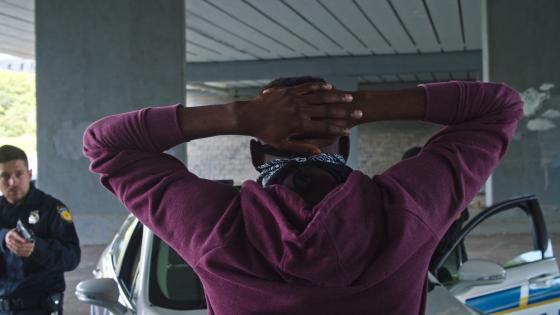In the US debate over policing, in which no one seems to agree on anything, there is one important (if implicit) point of agreement: policing cannot be changed. That belief is not only at the heart of calls to defund or abolish the police, but also at the heart of concerns about police reforms – that we cannot change departments in ways that reduce the harms of policing without also compromising their ability to keep the public safe.
Recent evidence suggests these conclusions are wrong. Many (perhaps most) police departments perform far below their potential because of how they are managed. One hopeful implication of this discovery is that if we can improve police management, we can reduce crime and the harms of policing simultaneously.
Could better management lead to better policing?
Consider the experience of the three largest cities in the US: New York, Los Angeles, and Chicago. Despite their myriad differences, homicide rates in all three moved together for nearly a century (Figure 1). After peaking at the height of the crack cocaine epidemic in the early 1990s, those rates fell by 80–90% in New York and Los Angeles. Yet Chicago saw a much smaller decline that has now been almost fully reversed. What explains this divergence?
Figure 1 Homicide rates in New York City, Los Angeles, and Chicago, 1889–2020
Note: Chicago homicide data for 1889 through 1930 from the Chicago Historical Homicide Project at Northwestern University. Chicago homicide data for 1930 through 1959 from the FBI’s Uniform Crime Reports (ICPSR 3666). Los Angeles homicide data for 1916 through 1959 from the Historical Violence Database at the Criminal Justice Research Center, the Ohio State University. New York City homicide data for 1890 through 1959 from the National Institute of Justice (ICPSR 3226). Homicide data for 1960 through 2019 from the FBI’s Uniform Crime Reports (Open ICPSR). Homicide data for 2020 from the police departments of Chicago, New York City, and Los Angeles.
When we see a pattern like this, we tend to think the explanation must lie with determinants of violence, such as socioeconomic conditions. But over the last 30 years, the poverty rate in Chicago declined by at least as much as poverty rates in New York and Los Angeles.
A different explanation offered by many criminologists is policing (Stone et al. 2009, Zimring 2011). Traditionally, research on whether police reduce crime has focused on two main levers: departments’ size and strategy. Credible research finds that hiring more cops can reduce crime, particularly violent crime, with little effect on serious arrests (though there is some evidence of more arrests for minor offenses in minority communities).1 In recent decades, police departments have adopted (and researchers have studied) strategies ranging from hot-spot policing to community and problem-oriented policing, with the goal of reducing crime but also of increasing accountability, transparency, fairness, and legitimacy (e.g. Skogan and Hartnett 1999, Tyler 2003, Weisburd et al. 2008, Braga et al. 2014). But size and strategy do not seem to explain this divergence: Chicago had more officers per capita than its peers during this period and claimed to follow a policing strategy similar to that of most large departments.
An underexplored third lever for changing policing effectiveness is how well a department is managed, or how it implements its chosen strategy with the resources available. Management questions range from whether basic managerial ‘best practices’ are followed (such as gathering data to inform decisions), to whether front-line officers know what to do and how to do it, to which of those officers are promoted and become managers themselves. Studies of the private sector show that differences in management practices can explain substantial variation in firms’ output, and that improving those practices raises a firm’s productivity (e.g. Bloom et al. 2016 and 2017, Syverson 2011). Could the same be true of public sector organisations like police departments?2 Anecdotal evidence suggests it might: during parts of this period, New York and Los Angeles shared a leader in common (William Bratton) whose stated goal was to professionalise both departments.
This puzzle inspired us to approach the question more systematically.
Police leaders affect police outcomes
In a recent study analysing data from multiple police departments (Kapustin et al. 2022), we find evidence consistent with police not maximising output – operating within what economists call their production possibility frontiers (PPFs), or the maximum possible ‘outputs’ an organisation can get from a given level of resources or ‘inputs’. Improving management may be one way to improve police performance without a large infusion of resources.
We start by gathering data about socially important outcomes that police can affect, such as homicides and violent crimes, for the 50 largest departments in the US for up to two decades, as well as the tenures of their leaders during this period. We then look for evidence that police leadership matters. Our approach involves first measuring the relationship between who leads a department and the outcomes that occur during their tenure, and then calculating the likelihood of the observed relationship occurring by chance (Berry and Fowler 2021).
Using this method, we find evidence that who leads a department affects both public safety (violent crimes) and policing harms (civilians killed by police). Differences in these outcomes across leaders’ tenures are large: during a quarter of them, rates of violent crime and civilians killed by police deviate from their department averages by at least 16% and 36%, respectively. We also replicate this cross-city analysis using data from Chicago’s 22 police districts, each the size of a small- to medium-sized city’s police department and led by a district commander. The results are similar: district commanders affect shootings and use-of-force incidents. In both the cross-city and Chicago analyses, many leaders’ tenures saw reductions in violence and in harms from policing. This suggests it may be possible not only to change departments, but to do so in ways that improve simultaneously the two types of policing outcomes that society cares about most.
These results are consistent with, though not definitive proof of the theory that management matters for policing outcomes. We next look for evidence that actively improving management can improve policing outcomes as well, using as our case study an intervention introduced in Chicago’s highest-violence police districts in 2017.
A management intervention: Chicago’s Strategic Decision Support Centers
In 2016, Chicago experienced a surge in gun violence that caused homicides to rise nearly 60% in a single year. A team of outside experts invited to assess the Chicago Police Department’s (CPD) proactive policing strategy found its implementation lacking: data were being collected and sometimes analysed centrally, but they were seldom used by district commanders to allocate their resources and inform their operations. These experts recommended establishing planning processes and hubs, called Strategic Decision Support Centers (SDSCs), within each district. In addition to receiving several new technologies, like an acoustic gunshot detection system (ShotSpotter) and place-based predictive policing software (HunchLab), each SDSC had an analyst who was trained on all of CPD’s software tools conduct analyses of local crime patterns at the commander’s request.3 Starting in early 2017, SDSCs were implemented in the six highest-violence police districts (‘Tier 1 districts’) in Chicago.
We use two features of the SDSCs to expand our understanding of management’s role in determining policing outcomes: HunchLab and the staggered rollout of SDSCs.
HunchLab, the predictive policing software deployed in SDSC districts, shows officers 300m x 300m ‘boxes’ within their beats that it predicts have a higher likelihood of violent crime, and recommends additional patrols.4 Which boxes were shown to officers during a given shift was determined by a random lottery.5 Using information for each box and shift that reveals whether the box was shown to officers, gunshots were detected (from ShotSpotter), and officer time spent at the location (from GPS data), we estimate the effect of additional officer time on gun violence for each of the six Tier 1 police districts in 2017.
Figure 2 Dose-response relationship between officer time and ShotSpotter alerts in HunchLab boxes
Note: Data from the Chicago Police Department. Each point represents the average deviation from the mean of officer time in a box (x-axis) and ShotSpotter alerts in a box (y-axis), by district, separately for boxes that were shown (blue) and boxes that were not shown (red) in the matched analysis sample. The size of each point is proportional to the number of observations it contains, and the weight each point receives in a two-stage least-squares regression of ShotSpotter alerts on officer time in a box and district fixed effects, instrumenting for officer time with interactions of district fixed effects and whether a HunchLab box was shown. This is similar to the approach used to generate the partial regression leverage plots in Figure 2 of Kling et al. (2007).
Figure 2 reports the result of this analysis. Each point represents the difference in officer time (x-axis) and gunshots (y-axis) from the district average for boxes in each district, separating boxes that were shown to officers from those that were not. For most districts, it appears that when HunchLab showed boxes to officers, they spent more time in the districts and shootings decreased. And yet, despite the apparent gains from using this information to direct patrol resources, we cannot statistically rule out the possibility that HunchLab’s recommendations had no effect on where officers spent their time in four of the six Tier 1 police districts. Some commanders might have told their officers to disregard HunchLab’s recommendations because additional patrol time in the boxes was less productive in their district than in others. But we see no evidence to suggest that commanders were optimising in this way; rather, it appears that HunchLab’s recommendations were simply not followed in many districts, despite their apparent value and the low cost of adopting them. This pattern is consistent both with districts not maximising output given their resources (operating within their PPFs) and with there being variation across districts in the degree to which this is true.
The staggered rollout of SDSCs also allows us to estimate their impact on policing outcomes. Unlike other policing interventions, the SDSCs principally seek to improve management in a district by giving a commander tools and processes to more effectively manage their resources. Crucially, the SDSCs did not increase the number of officers (or hours worked) in a district, nor did they usher in a new kind of policing strategy. To estimate their impact, we can compare outcomes in the six Tier 1 districts that received SDSCs in 2017 to those in the 16 districts that did not. Yet, because the six Tier 1 districts historically had the highest levels of violence and saw the largest increases in 2016, they might have experienced unusually large violence declines in 2017 due to mean reversion rather than the SDSCs. We avoid this issue by creating a weighted set of non-SDSC districts with outcomes that closely resemble those of Tier 1 districts, giving us greater confidence that any difference we observe between them in 2017 represents the impact of the SDSCs.
We find that, through the first three months of having an SDSC, the Tier 1 districts saw statistically significant declines in shooting victimisations (-21%) and violent felonies (-8%), with no detectable changes in overall arrests, traffic stops, or uses of force. This pattern of results suggests it is possible for a management intervention that costs less than 1% of the Chicago Police Department’s annual budget to meaningfully improve public safety without exacerbating the harms of policing. Yet we also find that, by 11 months after the launch of SDSCs, these public safety benefits appear to attenuate while drug arrests appear to increase, potentially underscoring the difficulty in sustaining improvements in management practices.
Conclusion
Trust in policing in the US is near all-time lows (Brenan 2021), while rates of homicides in many US cities are near all-time highs (Elinson 2022). It is perhaps understandable that many people feel police cannot produce more public safety and fewer harms.
The good news is that the research summarised here suggests this view is wrong: policing can be improved without changing policing strategies or how departments are resourced. Improving how police departments are managed may be one way to significantly increase their output on both dimensions, and potentially at low cost: each SDSC in Chicago had a start-up cost of $2 million, compared to the Chicago Police Department’s annual budget of $1.7 billion. The bad news is that the same research suggests that far too many police departments across the country are underperforming by providing the communities they serve with too little safety and too many avoidable enforcement harms.
Getting this right is important for the future of our cities and particularly for communities of colour, on whom the burdens of suboptimal policing – a deficit of safety, a surplus of policing harms –disproportionately fall. Just as the homicide decline of the 1990s and 2000s raised life expectancy substantially for Black men (Sharkey and Friedson 2019), so too would the benefits of improved policing accrue largely to them. However, this will require further research into what management practices are most promising for improving police performance, how to implement such policies, and the effects of doing so.
References
Berry, C R and Anthony Fowler (2021), "Leadership or luck? Randomization inference for leader effects in politics, business, and sports", Science Advances 7(4): eabe3404.
Bloom, N, E Brynjolfsson, L Foster, R Jarmin, M Patnaik, I S Eksten and J V Reenen (2017), “Adding a piece to the productivity puzzle: Management practices”, VoxEU.org, 17 May.
Bloom, N, R Lemos, R Sadun and J V Reenen (2014) “We don’t need no (management) education”, VoxEU.org, 07 December.
Bloom, N, R Sadun and J V Reenen (2016), "Management as a Technology?," NBER Working Paper No. w22327.
Braga, A A, A V Papachristos and D M Hureau (2014), "The effects of hot spots policing on crime: An updated systematic review and meta-analysis", Justice Quarterly 31(4): 633–663.
Brenan, M (2021) “Americans' Confidence in Major U.S. Institutions Dips”, Gallup, 14 July.
Chalfin, A, B Hansen, E K Weisburst and M C Williams (forthcoming), “Police force size and civilian race”, American Economic Review: Insights.
Draca, M, S Machin and R Witt (2007), “Policing and crime: evidence from the London bombings re-deployment”, VoxEU.org, 06 August.
Elinson, Z (2022), "Murders in U.S. Cities Were Near Record Highs in 2021", Wall Street Journal, 6 January.
Evans, W N and E G Owens (2007), "COPS and Crime", Journal of public Economics 91(1-2): 181–201.
Kapustin, M, T Neumann and J Ludwig (2022), "Policing and Management", NBER Working Paper No. w29851.
Kling, J R, J B Liebman and L F Katz (2007), "Experimental analysis of neighborhood effects", Econometrica 75.1: 83¬–119.
Levitt, S D (1997), "Using electoral cycles in police hiring to estimate the effects of police on crime", American Economic Review 87(3): 270¬–290.
Levitt, S D (2002), "Using electoral cycles in police hiring to estimate the effects of police on crime: Reply", American Economic Review 92(4): 1244¬–1250.
Mello, S (2019), "More COPS, less crime", Journal of Public Economics 172: 174–200.
Owens, E G (2013), "1 cops and cuffs", in Lessons from the economics of crime: what reduces offending? Cambridge: MIT Press, 17.
Sharkey, P and M Friedson (2019), "The impact of the homicide decline on life expectancy of African American males", Demography 56(2): 645–663.
Skogan, W G and S M Hartnett (1999), Community policing, Chicago style, Oxford University Press.
Stone, C, T S Foglesong and C M Cole (2009), Policing Los Angeles under a Consent Decree: The Dynamics of Change at the LAPD, Cambridge, MA: Program in Criminal Justice Policy and Management, Harvard Kennedy School.
Syverson, C (2011), "What determines productivity?", Journal of Economic Literature 49(2): 326–65.
Tyler, T R (2003), "Procedural justice, legitimacy, and the effective rule of law", Crime and Justice 30: 283–357.
Weisburd, D, C W Telep, J C Hinkle and J E Eck (2008), "The effects of problem‐oriented policing on crime and disorder", Campbell Systematic Reviews 4.1: 1–87.
Zimring, F E (2011), The City that Became Safe: New York’s Lessons for Urban Crime and its Control, Oxford University Press.
Endnotes
1 See, for example, Levitt (1997, 2002), Evans and Owens (2007), Owens (2013), Mello (2019), and Chalfin et al. (forthcoming). A related literature considers the impact of greater police presence from redeployments on crime and arrives at broadly similar conclusions (e.g. Draca et al. 2007).
2 For evidence about the importance of management for a different public-sector organisation, namely, schools, see Bloom et al. (2014).
3 Our research center, the University of Chicago Crime Lab, provided analytical support to the SDSCs until CPD could hire its own crime analysts; see Appendix C in Kapustin et al. (2022) for details and a discussion of potential conflicts of interest.
4 Due to Chicago’s high degree of racial segregation, and because HunchLab was used only to re-allocate patrol activity within rather than across beats, HunchLab has little effect on the racial composition of places receiving more patrol time.
5 Unlike a traditional random lottery, in which each box has an equal chance of being shown, in this lottery a box’s chance of being shown was a function of its predicted probability of experiencing violence.








